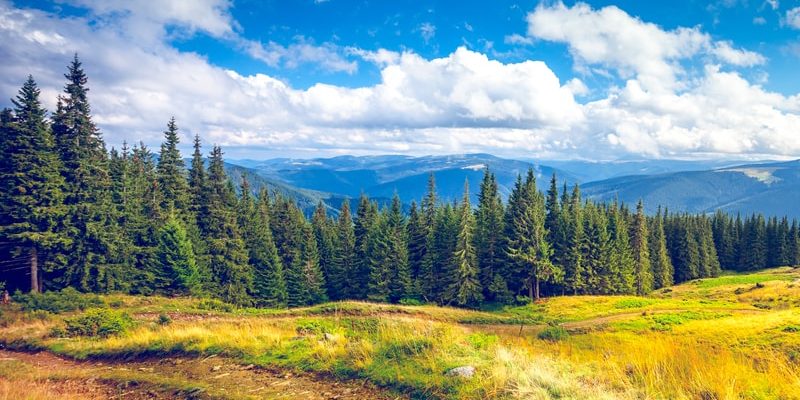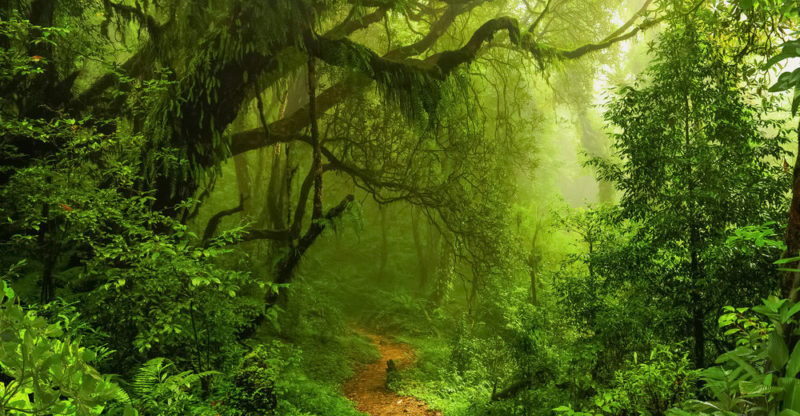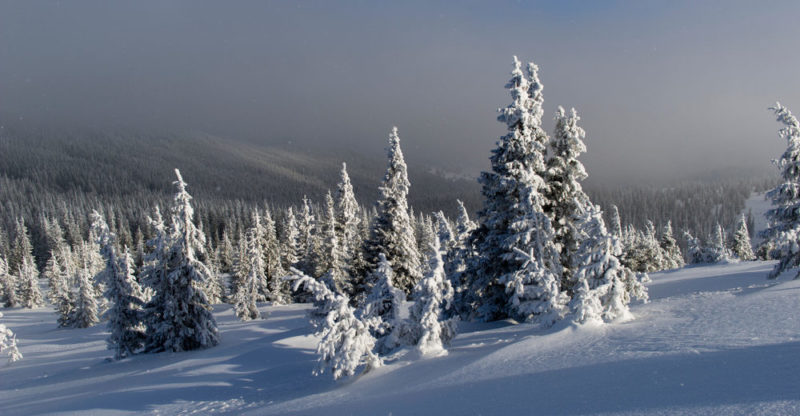We explain what forests are, how they are classified and the flora and fauna they present. Also, what are its characteristics and importance.
What are forests?
When we speak of forest we refer to an ecosystem in which large and lush vegetation predominates , generally spread over large areas, adapted to different types of climate , land and relief . These large plant deposits contain a good part of the planet's biodiversity and are spread over the five continents.They are, therefore, very important ecosystems for life, whose participation in natural cycles such as hydrological and carbon is notorious . In addition, its contribution to the development of humanity in the form of raw materials ( wood , fibers, food, etc.) played a vital role in the accumulation of goods that led to the Industrial Revolution , and even meant paying the price of logging and the deforestation , current ecological concerns forests.
Origin of forests
Forests arose on our planet almost 400 million years ago , when the first plant organisms left the sea , conquered the land and proved to be extremely effective in conquering dry territory, already irrigated by the rain cycle , and CO 2 that abounded in the atmosphere.Thus, the forests were the product of the plant accumulation of highly competitive species in the most fertile, most favorable, wettest and probably warmest places, whose characteristics were ideal for the development of ever taller trees, in frank competition for light. solar and soil.
Eventually, the species adapted to the different environments that appeared on Earth as the continents moved and diversified, thus giving rise to forests of all kinds, conditioned to colder and drier climates, to soils with different composition, etc
Abundance of forests
 Forests can be found on any of the five continents , in the most different latitudes and climatic regions. As a whole, the Earth has about 4,000 million hectares of forest, which represents 30% of its surface and 56% of these hectares are in tropical or subtropical regions.
Forests can be found on any of the five continents , in the most different latitudes and climatic regions. As a whole, the Earth has about 4,000 million hectares of forest, which represents 30% of its surface and 56% of these hectares are in tropical or subtropical regions.Regarding the distribution by countries, it is estimated that the largest forests are in: Russia (20%, 814,931 hectares) , Brazil (12%, 493,538 hectares), Canada (9%, 347,069 hectares), United States (8% , 310,095 hectares), China (5%, 208,321 hectares) and the Democratic Republic of the Congo (4%, 152,578 hectares).
Forest types according to foliage
 According to the presence or absence of leaves during autumn and the arrival of cold in most of the trees that make up a forest, we can classify them based on two categories:
According to the presence or absence of leaves during autumn and the arrival of cold in most of the trees that make up a forest, we can classify them based on two categories:
- Deciduous forests. Those in which the fall of the leaves predominates, that is, their trees lose their foliage during part of the year.
- Evergreen forests. Those in which the leaves are evergreen, that is, constant, with no leaf fall occurring other than in the case of dead leaves.
Forest types according to vegetation
 Another possible classification of forests is based on the type of vegetation that predominates. Thus, one can speak of:
Another possible classification of forests is based on the type of vegetation that predominates. Thus, one can speak of:
- Hardwood forests (broadleaf). Such as jungles and angiosperm forests, whose leaves are large and usually have bushy branches, with a lot of competition for sunlight.
- Coniferous forests (needle leaf). Those such as the boreal forest or taiga, in which thin and pointed leaves predominate, like non-wounding thorns or threads.
- Mixed forests. Those cases in which there is a balance between both trends.
Forest types according to climate
 Finally, forests can be classified according to the climate in which they thrive, according to the following categories:
Finally, forests can be classified according to the climate in which they thrive, according to the following categories:
- Boreal forests. They predominate in polar or subpolar climates , they are usually conifers with evergreen leaves, adapted to low temperatures .
- Temperate forests. Those found in temperate and continental climates , especially in warmer regions. They can be broad-leaved deciduous, or coniferous evergreen, adapted to regions of great thermal amplitude, with hot summers and cold winters.
- Subtropical forests. They proliferate in humid or dry subtropical regions and favor mixed vegetation.
- Tropical forests . Known as jungles, they present an enormous variety of species of lush and exuberant leaf, evergreen, in regions around the equator where rainfall is abundant and it is hot almost all year round, with no distinct weather seasons.
Forest fauna
 Forests are usually home to a good number of known animal species . Very especially in tropical forests of gigantic biodiversity , in which there are even regions unknown to man where unknown animal species could inhabit.
Forests are usually home to a good number of known animal species . Very especially in tropical forests of gigantic biodiversity , in which there are even regions unknown to man where unknown animal species could inhabit.Rainforests have two-thirds of the world's fauna and flora, which represents a veritable hotbed of species in constant competition with each other.
Forest flora
As in the case of fauna, forests contain a high percentage of known plant species (and the total of the possible unknown), so that according to many the equatorial forests could have a true “pharmacy” unknown to man , with species capable of healing many of the contemporary diseases.
Importance of forests
 Beyond what we have already pointed out about the biodiversity contained in forests and the possible pharmacological, economic uses, etc. What this plant and animal abundance can mean, forests play a vital role in the perpetuation of life on the planet:
Beyond what we have already pointed out about the biodiversity contained in forests and the possible pharmacological, economic uses, etc. What this plant and animal abundance can mean, forests play a vital role in the perpetuation of life on the planet:
- They allow the replacement of atmospheric oxygen , since they take CO 2 and through photosynthesis they release oxygen necessary for breathing;
- They allow the fixation of carbon , which introduces the carbon of this atmospheric gas into their bodies , keeping its levels in the atmosphere stable and avoiding the accumulation of greenhouse gases .
Economic impact of forests
 The economic use of the resources that the forests represent is extremely diverse: from the use of wood for the furniture and construction industry , cork, rubber and paper ; the processing of plant species that contain pharmacologically usable biochemical elements (anesthetics, antibiotics , antiseptics, etc.); or food inputs such as fruits, fibers, roots, leaves, microorganisms , fungi , etc.
The economic use of the resources that the forests represent is extremely diverse: from the use of wood for the furniture and construction industry , cork, rubber and paper ; the processing of plant species that contain pharmacologically usable biochemical elements (anesthetics, antibiotics , antiseptics, etc.); or food inputs such as fruits, fibers, roots, leaves, microorganisms , fungi , etc.
Ecological risk of forests
All those economic virtues that forests contain have been exploited for centuries at a high cost to the ecosystem .The extinction of animal and plant species as a result of indiscriminate logging or deforestation is one of the main ecological problems that many international organizations seek to stop, to save the so-called “lungs of the planet”.
The contamination of soils , the acid rain and mining illegal activities are also very high impact on the forests of the world.
The above content published at Collaborative Research Group is for informational and educational purposes only and has been developed by referring reliable sources and recommendations from technology experts. We do not have any contact with official entities nor do we intend to replace the information that they emit.
Cultural journalist with great interest in education and technological innovation in the classroom. The future passes through technology and it is already here. .
Leave a reply
Your email address will not be published. Required fields are marked *Recent post

Sport: What Is It, Types, Risks, Features, Characteristics and Examples
September 23, 2021

Dogs: Emergence, Features, Characteristics, Feeding and Breeds
September 24, 2021

Story: Definition, Elements, Structure, Features and Characteristics
September 24, 2021

Essay: Definition, Structure, Features, Characteristics, How to Do It
September 24, 2021
